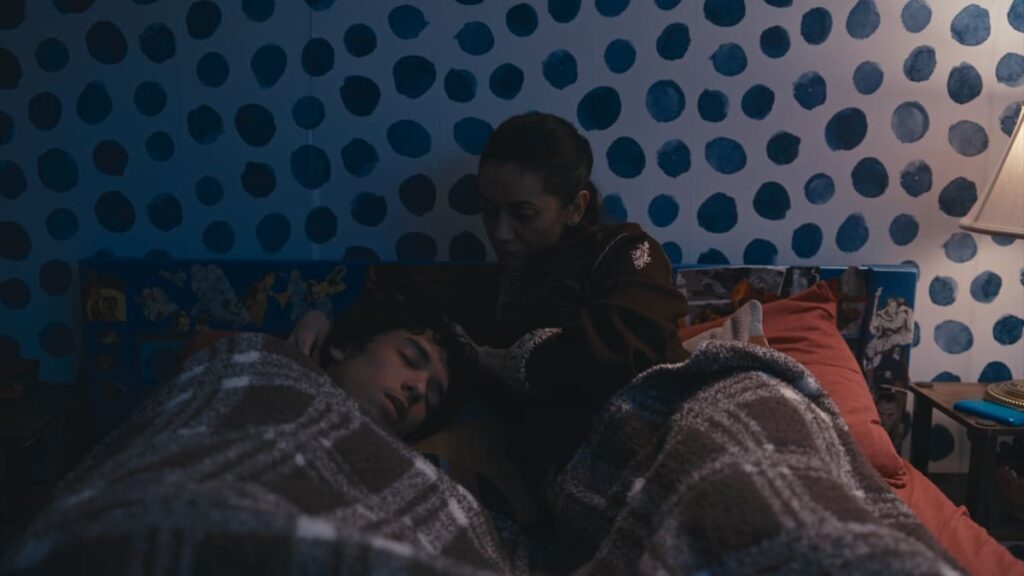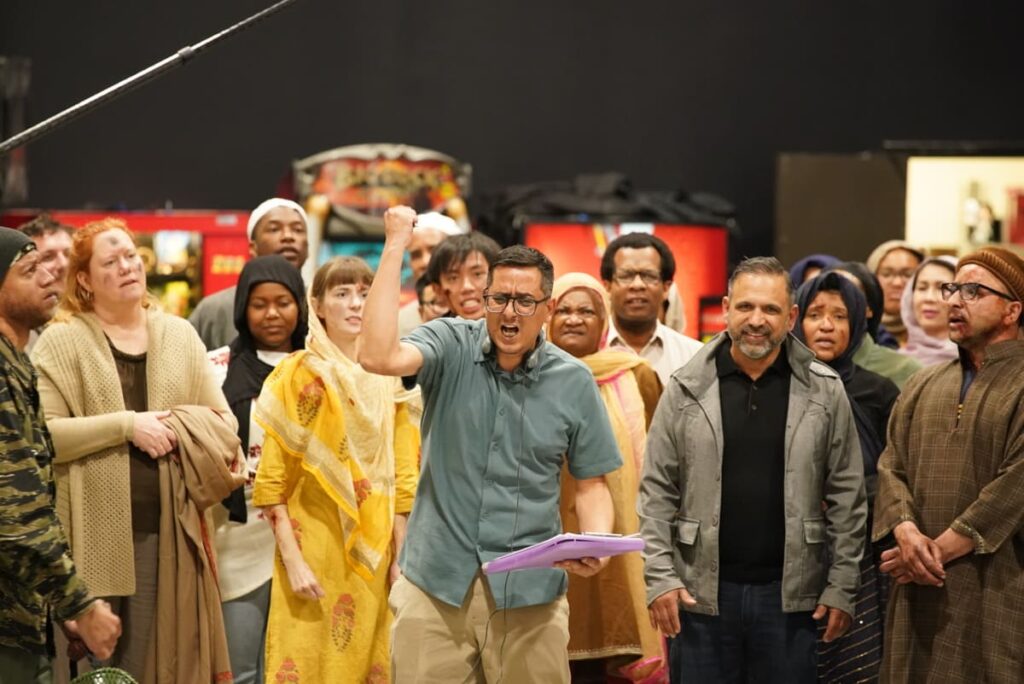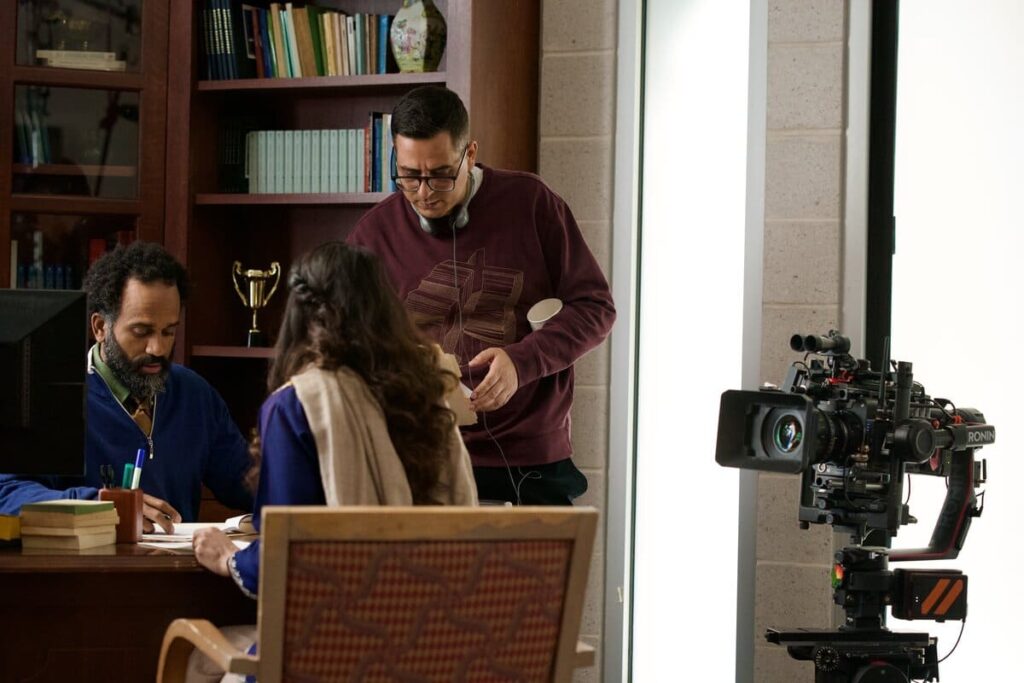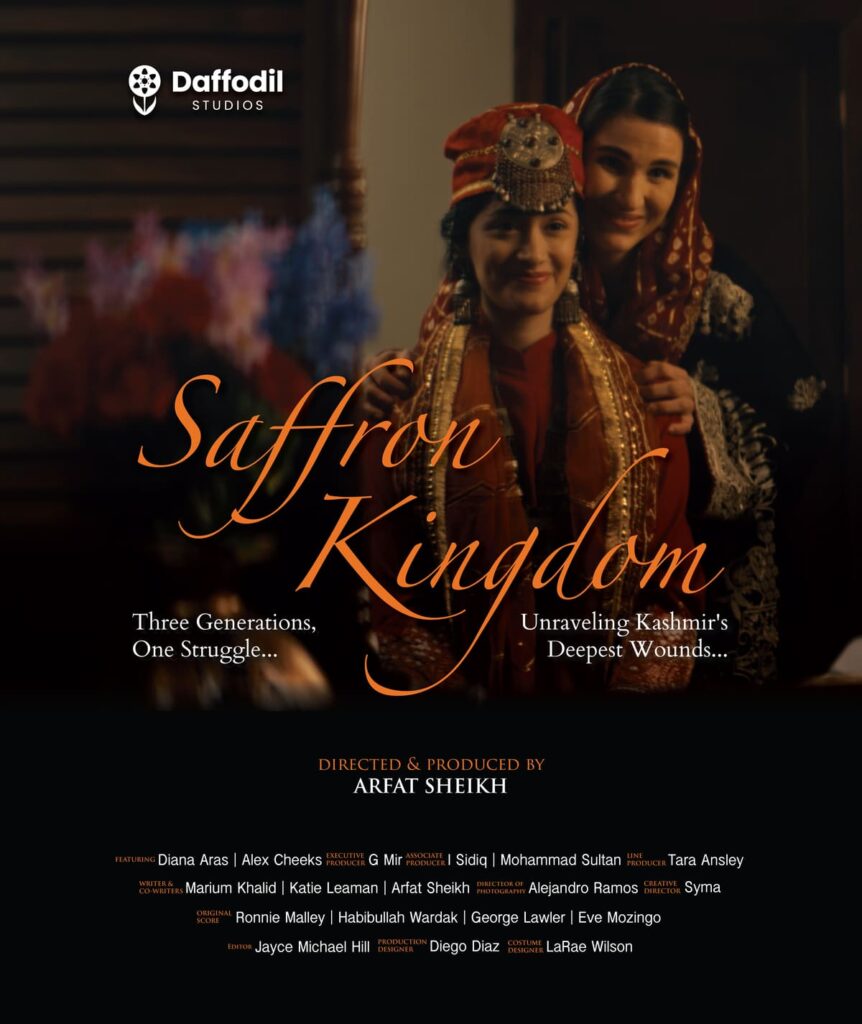In this exclusive IndieWrap interview, Sheikh opens up about reclaiming agency through storytelling, the emotional weight behind key scenes, and the challenges of filming across continents under constant constraint. More than just a film, Saffron Kingdom is an act of resistance—a human story about grief, dignity, and the power of truth when told from within.
What sparked the decision to tell this story through film?
The decision came from a place that’s both deeply personal and deeply political. Growing up in Kashmir, conflict wasn’t a distant headline—it was our everyday reality. You woke up to news of who had died, not who had lived. The story was always about body counts, never about names, never about lives. It was numbing.
People in Kashmir stopped trusting the local media long ago. Instead, we’d tune in to BBC or Deutsche Welle to catch rare moments when someone outside seemed to care. Our own voices were buried under state propaganda, silence, or outright distortion. And then Bollywood entered the narrative war.
The Bollywood of the 1990s started meddling in the story of Kashmir with films like Roja, Mission Kashmir, and Fanaa. These weren’t just films—they were weapons of perception. They painted Kashmiris as extremists, as villains. There was never space for us to just be human. No mother trying to protect her child, no father trying to make ends meet. Just shadows with guns. When you grow up with that kind of portrayal dominating the mainstream, it seeps into how people see you—even outside of Kashmir.
I remember living in Delhi, and the fear I felt every time I told someone I was Kashmiri. You could feel the shift in their body language, the discomfort, the suspicion. That’s the level of damage misinformation and narrative control can cause. And then there’s my father’s story—a personal tragedy that remains unresolved. He was taken from us in a way no one should ever experience, and his death was never investigated with any real intent. That pain never got closure. It became part of my identity, part of the silence I carried.
Years later, while filming documentaries back home, I met people who had lived through the same—if not worse. Mothers waiting for sons who never returned. Children growing up with unanswered questions. And still, despite everything, they endured. Their resilience moved me. That’s when I realized this film couldn’t just be mine—it had to be ours. A story that doesn’t just mourn the pain but also honors the strength that keeps Kashmiris going.

What were the greatest challenges of working under such contrasting and constrained environments?
Filming in Kashmir had to be done quietly—almost in whispers. I couldn’t be there myself; it was simply too risky. The political climate is tense, heavily surveilled, and even something as innocuous as a tripod can arouse suspicion. Everything was coordinated remotely. For the exterior shots, we brought in a small crew from Bombay under the impression they were working on a documentary. That was deliberate. It kept the true nature of the project concealed—and kept everyone safe. We moved in silence, took no chances, and carried the story like a secret.
Atlanta presented an entirely different set of challenges—no less intense, just different. We had to recreate Kashmir from the ground up and make it feel like home. That meant obsessing over every detail: set design, wardrobe, locations. I was incredibly fortunate to have two Kashmiris on the team—Ikhwan, our Associate Producer, and Saima, the Art Director. They brought not only their creative vision but also their lived experience. Both were visual storytellers who became the cultural compass for the entire production.
One of the biggest hurdles was the lack of Kashmiri actors and crew. But strangely, that turned into one of the most meaningful parts of the journey. The people who did join us embraced the story wholeheartedly. Laura Lopez and Ahmed Ghafourri learned their Kashmiri lines in just a few days—it was remarkable. They didn’t just act; they gave themselves fully to the story. In doing so, they became allies, carrying it forward as if it were their own.

How did you approach writing and directing the emotionally layered mother-son relationship?
The mother-son relationship at the heart of the film was shaped through an evolving writing process. It began with early idea exchanges between Marium and me, where we laid the emotional foundation through shared notes, conversations, and deep reflection. Later, Katie joined the process, and she and I worked closely to refine the final drafts. Her perspective brought new clarity, deepening the emotional nuance and grounding the story even further in truth.
Our writing was deeply informed by real interviews with Kashmiri mothers who had endured profound loss. Some elements also came from my own childhood—memories that resurfaced unexpectedly during the act of writing. This process went beyond character-building; it was about listening, honoring, and translating lived experience into narrative form.
Directing this film was intensely personal. I carried its weight every day because it wasn’t just a story—it was something lived and inherited. There was no distance between me and the material. Every choice—how a scene felt, how silence hung in the air, how grief moved through a room—came from a place I knew too well.
Working with Diana Aras and Alex Cheeks was intense in the best way. We didn’t just rehearse scenes; we unpacked what these characters had been through and what they’d lost. They listened, felt it deeply, and gave everything they had. What they brought wasn’t just performance—it was presence. They showed up with their whole selves, and it transformed the film.
Behind the camera, I had the privilege of working with an exceptional team. Alejandro Ramos, our Director of Photography, brought a quiet intensity to every frame. He understood the rhythm of silence, the weight of unspoken emotion, and how to translate that visually. Katerina Gerlach, our First Assistant Director, ran a tight yet compassionate set. Her organization and clarity were invaluable, especially given the challenge of recreating Kashmir in Atlanta. The G&E team worked with precision and heart, and our production assistants—each and every one of them—went above and beyond. They were the invisible force that held everything together.
This film was built in layers—through collaboration, trust, and a deep shared belief in the story.
How did you balance historical context with the personal narrative to make it accessible to a global audience?
I knew from the beginning that if I focused too much on politics, I’d lose the human story. So I along with both the writer always chose to center the film on a single family—a mother, a son, their grief, their resilience. Through them, we could touch on the bigger historical events like the abrogation of Article 370 or the Gawkadal massacre, but in a way that felt intimate and lived-in, not like a history lesson. This allowed people from completely different cultures to find their way into the story—not because they knew Kashmir, but because they knew love, loss, and what it means to fight for dignity.

What do you think resonated so strongly with juries and audiences?
I think it’s the honesty. The film doesn’t pretend. It doesn’t try to impress with spectacle or hide behind metaphors. It looks you in the eye and says, “This is what it’s like to be forgotten, and still survive.”
There’s something disarming about that. Even people who knew nothing about Kashmir came up to me afterward with tears in their eyes. The film doesn’t ask for pity—it asks for recognition. And that’s a powerful thing.
How do you see your role in shaping narratives around Kashmir?
I see myself as a witness. As someone who lived it, who carries it, I feel a responsibility to tell stories that have been erased or twisted beyond recognition. Mainstream Indian media has painted Kashmiris as either terrorists or tokens. We’re either feared or fetishized. Rarely are we seen as full, flawed, beautiful human beings.
Through my work, I want to push back against that. I want to tell stories that complicate the narrative—that make people uncomfortable in the right ways and open them up to new truths.
What was the most emotionally difficult scene for you to write or shoot, and why?
There are two. One is a quiet scene between a brother and sister—Parveen and Hameed—after the massacre. They’re just sitting with their grief, trying to make sense of what they’ve lost. That one broke me a little. I remember standing behind the monitor, trying to hold it together. The other is when young Rizwan, haunted by nightmares of his father’s disappearance, wets his bed. The tenderness between him and his mother in that moment—it felt so close to my own childhood. My father disappeared in real life. That wound still aches. Filming that scene wasn’t just art—it was a reckoning.

How vital was creative freedom in telling this story your way, and what role did your executive producer play in that?
Creative freedom wasn’t just important—it was the lifeline of this film. Without it, Saffron simply wouldn’t exist as it does today. The truth we needed to tell is uncomfortable, complex, and often inconvenient. If we had gone through traditional studios or funding routes, there would have been relentless pressure to dilute, sanitize, or reshape the story into something more “acceptable” or “market-friendly.” But I refuse to tell a half-truth, especially when it comes to the pain and resilience of my people. Neutrality in this context isn’t honesty—it’s erasure.
I’m incredibly grateful to our executive producer, Dr. G. Mir, who is Kashmiri American himself. From the very beginning, he stood firmly by this project, unwavering in his belief that this story must be told authentically and without compromise. His trust gave us the freedom to make every choice—whether in writing, casting, or editing—with integrity and courage. Without his support, this film would never have been possible. He didn’t just fund the film; he championed our shared vision and honored our collective truth, even when it was difficult. That kind of allyship and faith is rare, and it’s something I deeply honor and appreciate every single day.
Could you expand on what reclaiming agency meant for you personally and politically?
For me, reclaiming agency meant saying: “You don’t get to tell my story anymore.” It was an act of defiance, but also of healing. Politically, it meant pushing back against decades of narratives designed to silence or vilify people like me. Personally, it meant turning grief into something that could breathe, speak, and maybe even move someone. This film isn’t just a film—it’s a form of resistance, a love letter, and a mirror all at once.

What do you hope viewers from vastly different cultural backgrounds take away from Saffron Kingdom?
I hope they leave with more questions than answers. I hope they feel something they didn’t expect to feel. I want them to see that behind the headlines and hashtags, there are real people—mothers, sons, neighbors—just trying to live with dignity. The film speaks about Kashmir, but it’s also about what it means to lose someone, to hold on, and to keep going. Those are things anyone can relate to, no matter where they come from. And if they walk away with even a flicker of empathy for people they’ve never met—that’s more than enough.
Where is Saffron Kingdom being screened next, and are there more screenings planned?
The next screening of Saffron Kingdom is scheduled for June 30, 2025, at the Hopkins Bloomberg Center in Washington, D.C. This event is part of an extensive screening tour across the U.S. and internationally. After Washington, D.C., the film will be shown in other cities including New York City and Los Angeles, followed by its international debut in Sydney, Australia, on August 9. Several screenings are also planned in the UK thereafter.
We are actively engaging with partners in additional countries to further expand the tour. Currently, we’re in the final stages of securing a distribution deal, and Saffron Kingdom is expected to be available on a streaming platform by the end of this year. More information about this will be announced soon.
Tickets for the Washington, D.C. screening can be purchased at: daffodilstudios.org/store










